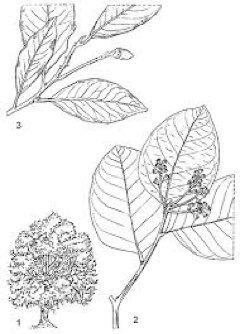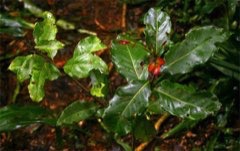 |
|
http://www.edibleplants.org |
 |
| biodiversityexplorer.org |
Translate this page:
Summary
Threatened by habitat loss, Ocotea kenyensis is an evergreen tree growing about 30 m in height, with a rounded crown and many branches. Its bole is commonly straight, branchless for up to 8 m, and about 100 cm in diameter. The bark is chewed to treat diarrhea and its decoction is used to treat cough. The wood of this species is moderately heavy and durable and ideal for flooring, furniture, carving, panelling, joinery, light construction, etc. It is also used as fuel and charcoal.
Physical Characteristics

 Ocotea kenyensis is an evergreen Tree growing to 20 m (65ft) by 18 m (59ft) at a fast rate.
Ocotea kenyensis is an evergreen Tree growing to 20 m (65ft) by 18 m (59ft) at a fast rate.
See above for USDA hardiness. It is hardy to UK zone 10.
Suitable for: light (sandy), medium (loamy) and heavy (clay) soils and prefers well-drained soil. Suitable pH: mildly acid, neutral and basic (mildly alkaline) soils. It cannot grow in the shade. It prefers moist soil.
UK Hardiness Map
US Hardiness Map
Synonyms
Ocotea gardneri Hutch. & M.B.Moss Ocotea viridis Kosterm. Tylostemon kenyensis Chiov.
Plant Habitats
Edible Uses
References More on Edible Uses
Medicinal Uses
Plants For A Future can not take any responsibility for any adverse effects from the use of plants. Always seek advice from a professional before using a plant medicinally.
Antidiarrhoeal Antitussive
A bark decoction is used in traditional medicine as an antitussive[299 ]. The bark is chewed to treat diarrhoea[299 ].
References More on Medicinal Uses
The Bookshop: Edible Plant Books
Our Latest books on Perennial Plants For Food Forests and Permaculture Gardens in paperback or digital formats.

Edible Tropical Plants
Food Forest Plants for Hotter Conditions: 250+ Plants For Tropical Food Forests & Permaculture Gardens.
More

Edible Temperate Plants
Plants for Your Food Forest: 500 Plants for Temperate Food Forests & Permaculture Gardens.
More

More Books
PFAF have eight books available in paperback and digital formats. Browse the shop for more information.
Shop Now
Other Uses
Charcoal Fuel Furniture Wood
Other Uses The heartwood is pale golden brown to dark brown, with blackish markings. The grain is often wavy; texture moderately fine; lustrous. The wood is moderately heavy; fairly durable and moderately resistant to termite and marine borer attacks, but susceptible to Lyctus attack. It saws and works satisfactorily with both hand and machine tools, but picking up of grain at the surfaces may occur; sharp cutting edges are recommended to obtain surfaces with a nice finish; gluing properties are satisfactory; the wood slices and peels well. The heartwood is moderately resistant to impregnation by preservatives. The wood is used for flooring, panelling, furniture and carving. It is suitable for light construction, joinery, interior trim, vehicle bodies, handles, ladders, sporting goods, toys, novelties, turnery, veneer and plywood[299 ]. The wood is used for fuel and to make charcoal[299 ].
Special Uses
Coppice
References More on Other Uses
Cultivation details
A plant of moderate to higher elevations in the moist tropics, where it is found at elevations up to 2,600 metres. The mean annual rainfall in the area of distribution ranges from 1,500 - 2,200mm[299 ]. The tree grows fairly rapidly[299 ]. Trees respond well to coppicing[299 ].
References Carbon Farming Information and Carbon Sequestration Information
Temperature Converter
Type a value in the Celsius field to convert the value to Fahrenheit:
Fahrenheit:
The PFAF Bookshop
Plants For A Future have a number of books available in paperback and digital form. Book titles include Edible Plants, Edible Perennials, Edible Trees,Edible Shrubs, Woodland Gardening, and Temperate Food Forest Plants. Our new book is Food Forest Plants For Hotter Conditions (Tropical and Sub-Tropical).
Shop Now
Plant Propagation
Seed - needs to be sown when fresh. The seed is sensitive to desiccation, but can be stored for a short period in moist sawdust[299 ]. Propagation by root suckers is easy; these are often produced abundantly[299 ].
Other Names
If available other names are mentioned here
Transvaal stinkwood - English, stinkhout - Afrikaans
Native Range
AFRICA: Ethiopia, Sudan (south), Kenya, Tanzania, Uganda, Democratic Republic of the Congo (east), Rwanda, Mozambique, South Africa (Eastern Cape, KwaZulu-Natal, Limpopo, Mpumalanga)
Weed Potential
Right plant wrong place. We are currently updating this section.
Please note that a plant may be invasive in one area but may not in your area so it's worth checking.
Conservation Status
IUCN Red List of Threatened Plants Status : Status: Vulnerable A1cd

Growth: S = slow M = medium F = fast. Soil: L = light (sandy) M = medium H = heavy (clay). pH: A = acid N = neutral B = basic (alkaline). Shade: F = full shade S = semi-shade N = no shade. Moisture: D = dry M = Moist We = wet Wa = water.
Now available:
Food Forest Plants for Mediterranean Conditions
350+ Perennial Plants For Mediterranean and Drier Food Forests and Permaculture Gardens.
[Paperback and eBook]
This is the third in Plants For A Future's series of plant guides for food forests tailored to
specific climate zones. Following volumes on temperate and tropical ecosystems, this book focuses
on species suited to Mediterranean conditions—regions with hot, dry summers and cool, wet winters,
often facing the added challenge of climate change.
Read More
Expert comment
Author
(Chiov.) Robyns & R.Wilczek
Botanical References
Links / References
For a list of references used on this page please go here
A special thanks to Ken Fern for some of the information used on this page.
Readers comment
| Add a comment |
|
If you have important information about this plant that may help other users please add a comment or link below. Only comments or links that are felt to be directly relevant to a plant will be included. If you think a comment/link or information contained on this page is inaccurate or misleading we would welcome your feedback at [email protected]. If you have questions about a plant please use the Forum on this website as we do not have the resources to answer questions ourselves.
* Please note: the comments by website users are not necessarily those held by PFAF and may give misleading or inaccurate information.
To leave a comment please Register or login here All comments need to be approved so will not appear immediately.
|
Subject : Ocotea kenyensis
|
|
|
|